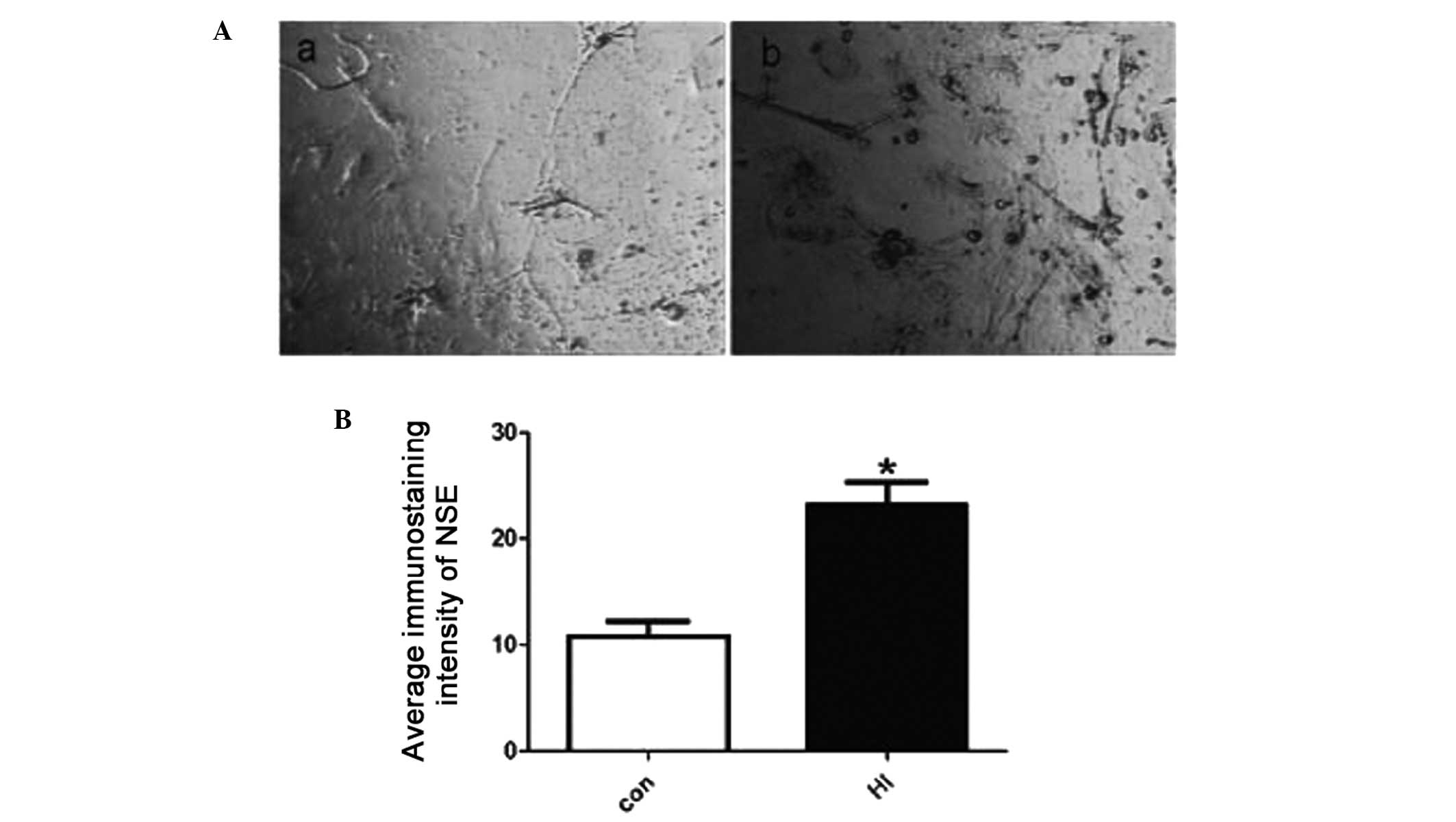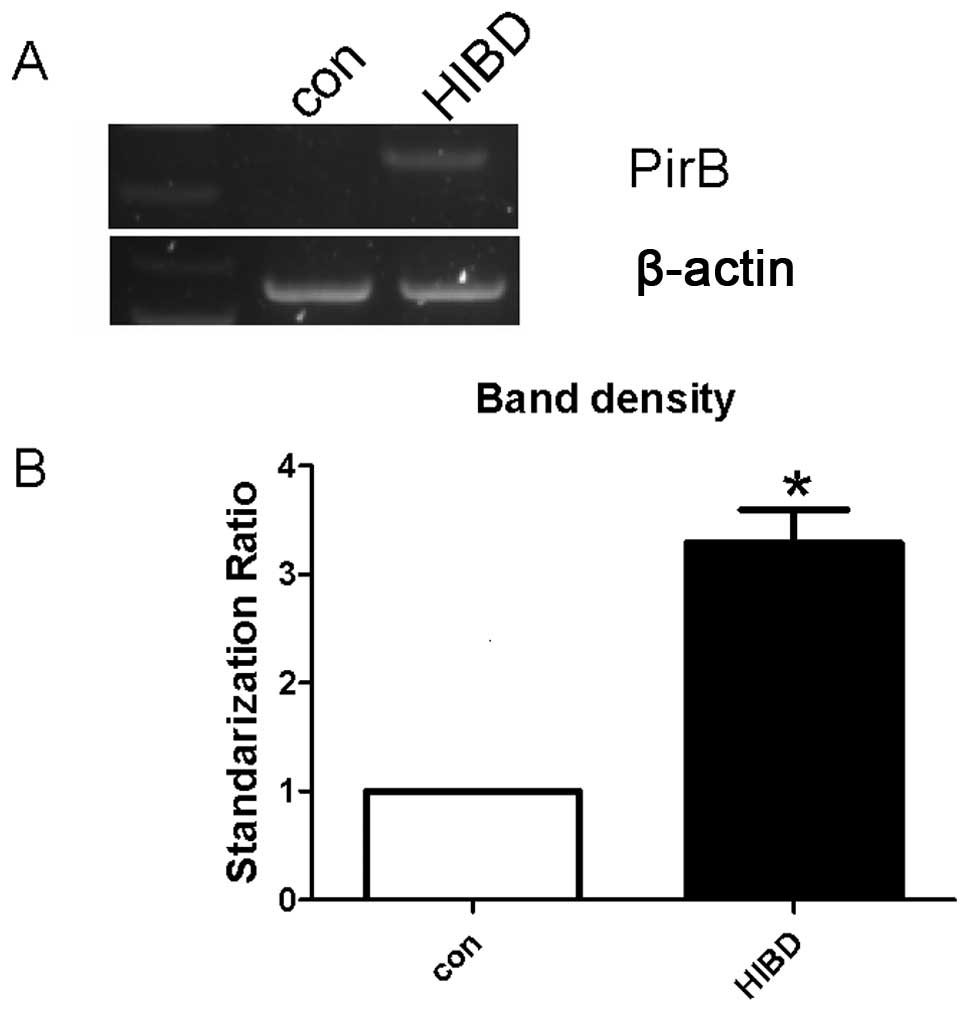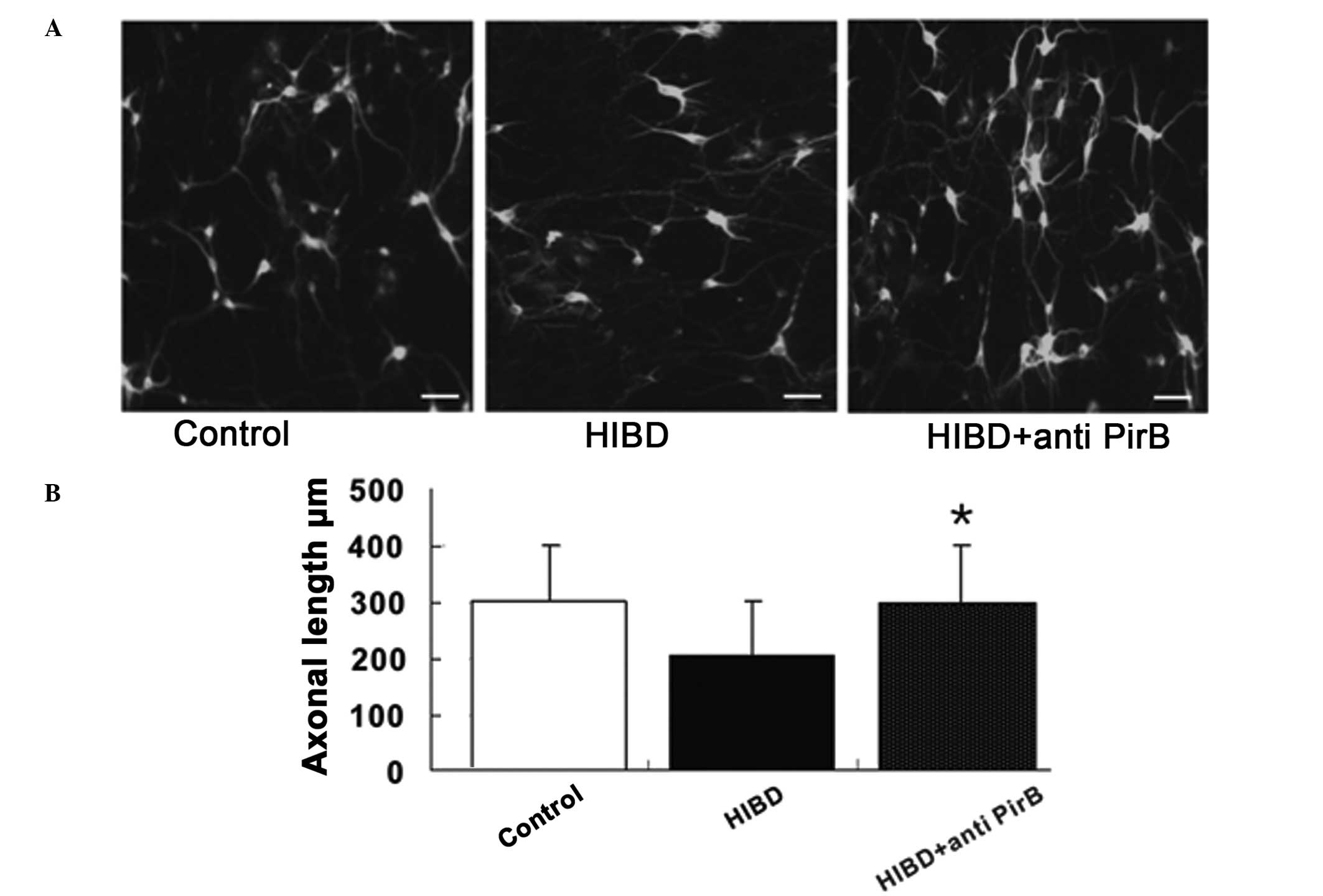PirB restricts neuronal regeneration in developing rat brain following hypoxia-ischemia
- Authors:
- Published online on: May 8, 2012 https://doi.org/10.3892/mmr.2012.907
- Pages: 339-344
Abstract
Introduction
Hypoxic-ischemic (HI) encephalopathy (HIE) is common in clinical neonatal brain damage (1). However, knowledge of HIE has always been limited. Most known treatments are symptomatic and prevent or relieve the damaging effects of hypoxia-ischemia to neurons. Prevention strategies are available (although limited), but currently no strategies for the support of recovery/repair are on the horizon, although hypothermia has been demonstrated in several large multicenter studies as an essential treatment. However, at present, no effective methods for promoting the regeneration of injured neurons have been identified. Therefore, new strategies for treating perinatal hypoxia-induced neuron injury are urgently needed (2).
The failure of axonal regeneration in the central nervous system (CNS) is largely attributed to the environment of the injured axons. The inhibitory activity is principally associated with CNS myelin components and the molecules in the glial scar at the lesion site. Previous studies suggested that three myelin proteins, i.e., the myelin-associated glycoprotein (MAG), Nogo-A and oligodendrocyte myelin glycoprotein (OMgp), collectively account for the majority of inhibitory activities in CNS myelin (3).
The inhibitory activities of MAG, OMgp and the extracellular domain of Nogo-A (Nogo-66) on HI-damaged neuron regeneration may be mediated by common receptor complexes consisting of the glycosylphosphatidylinositol-anchored Nogo receptor (NgR) and its signaling coreceptors (4–7). A number of studies have demonstrated that NgR may be involved in the pathology observed following HI in neonatal rats and that the inhibitory activity of NgR promotes axonal regeneration (8,9). However, no difference has been observed in the neurite outgrowth inhibition by the myelin inhibitors in the neurons of NgR-null and wild-type mice. Moreover, no corticospinal-tract (10) regeneration has been reported. Thus, a second receptor may mediate the inhibitory signaling of myelin inhibitors.
The paired-immunoglobulin-like receptor B (PirB), a second receptor, was originally identified in the cells of the immune system and, more recently, in those of the nervous system (11). Similar to NgR, PirB binds Nogo66, MAG and OMgp. PirB is also capable of inhibiting neurite outgrowth. The combined inhibition of NgR and PirB results in an almost complete regeneration of damaged nerves. Moreover, neurons of NgR-null mice which have been treated with PirB antibodies partially block the axonal regeneration inhibition by Nogo66 (12). These findings strongly suggest that compounds which target PirB and NgR enhance neuronal regeneration in spinal cord injuries. However, certain studies have indicated that PirB knockout in combination with NgR blockade did not promote axonal regeneration and that blocking the function of PirB is not sufficient to promote axonal reorganization or functional recovery following cortical injury in vivo (13,14). Therefore, it is possible that the PirB and NgR inhibitory signaling pathways have some unknown contacts. We aimed to investigate whether there were differences in the HI-damaged neurons of newborn rats.
In the present study, we hypothesized that the inhibition of PirB stimulates the regeneration of damaged nerves through the inhibition of the signal transduction of myelin inhibitors. PirB and NgR are functional receptors of myelin inhibitors and the inhibitory activity of NgR on axonal growth is mediated by the Rho-ROCK signaling pathways. Thus, we also hypothesized that the inhibitory activity of PirB is mediated by the Rho-ROCK signaling pathways. In the present study, we investigated the effects of PirB on axonal regeneration and explored the underlying signaling pathway in order to initiate the search for new methods that promote nerve regeneration.
Materials and methods
Animals
Two-day-old Sprague-Dawley rats were used in the experiments. The rats were obtained from the West China Medical Laboratory Animal Center and maintained in a conventional mouse facility. Protocols were approved by the Animal Care and the Guidelines of Animal Use and Protection of Sichuan University were followed. All possible efforts were made to minimize unnecessary suffering of the animals.
Primary cultures of cortical neurons
Sprague-Dawley rats were sacrificed by cervical dislocation. The cortices of rat were immersed in an ice-cold calcium- and magnesium-free Hank’s Balanced Salt Solution. The tissues were digested with trypsin (0.125% trypsin maintained at 37°C; HyClone Laboratories, Logan, UT, USA) for 30 min. The trypsin solution was decanted and the tissues were washed three times with serum-free Dulbecco’s minimal essential media (DMEM) (10 ml) (HyClone Laboratories) supplemented with 20% fetal bovine serum (HyClone Laboratories). The tissues were dispersed in this medium with a screen at room temperature. The cells were placed at 1.5×105 cells/cm2 in polylysine-coated 6-well plates (Becton Dickinson Labware, Franklin Lakes, NJ, USA) containing DMEM supplemented with 10% heat-inactivated horse serum, 10% heat-inactivated fetal bovine serum, 2 mM glutamine and 25 mM glucose without antibiotics. The cultures were maintained in a humidified 5% CO2 incubator at 37°C. On the second day, 10 μM Ara-C was added to the cultures to inhibit non-neuronal cell proliferation. Twice a week thereafter, half of the medium was replaced with fresh fetal bovine serum-free culture medium. The experiments on the cultured neurons were performed after 10 days.
HI neuron model
The neurons were randomly divided into four groups: negative control, deprivation of oxygen and glucose, anti-PirB antibody treatment and anti-PirB antibody-treated deprivation of oxygen and glucose. For the deprivation of oxygen and glucose group, the neurons were washed twice with sugar-free Earle’s culture medium, maintained in the same medium and placed in a humidified 5% CO2/95% N2 incubator at 37°C for 4 h. For the anti-PirB antibody treatment group, the cells were cultured in Earle’s culture medium supplemented with 50 μg/ml of 6C1, a specific anti-PirB antibody (Santa Cruz Biotechnology, Santa Cruz, CA, USA) targeting the PirB extracellular region. For the anti-PirB antibody-treated deprivation of oxygen and glucose group, the cells were cultured in Earle’s culture medium supplemented with 50 μg/ml of 6C1 and placed in a humidified 5% CO2/95% N2 incubator at 37°C for 4 h.
Immunocytochemistry
Following treatment, the cortical neurons were fixed with 4% paraformaldehyde for 10 min, washed three times with 0.01 M PBS for 5 min and blocked with 10% goat serum dissolved in PBS at room temperature for 1 h. The cells were then incubated together with anti-PirB antibodies overnight at 4°C, washed three times with 0.01 M PBS for 5 min, incubated together with goat anti-rabbit antibodies and visualized using DAB. The Metamorph software was used for capturing the images and quantification of the cell area. To measure the staining intensities, we graphically highlighted each individual neuron, including the nuclear region.
Neurite outgrowth assay
The isolated cortical neurons were placed in polylysine-coated 6-well plates. Following the treatments, the cultures were fixed for 30 min with 4% paraformaldehyde, permeabilized with ice-cold methanol and immunostained with rabbit polyclonal antibodies against βIII-tubulin (1:400; Santa Cruz Biotechnology). The slides were viewed under an inverted fluorescence microscope. The length of the longest neurite for each βIII-tubulin-positive neuron for the first 180–200 neurons encountered upon a systematic scanning of the slide was determined using the Simple PCI image analysis program. Neurite length quantitation and statistical analyses were performed as described previously (15).
Fluorescent staining
The cells were washed with PBS and fixed with 4% paraformaldehyde at room temperature for 10 min. After being washed twice with ice-cold PBS, the fixed cells were blocked with 5% BSA (Sigma, St. Louis, MO, USA) at room temperature for 30 min, followed by incubation with the primary antibodies and a specific anti-PirB antibody (Santa Cruz Biotechnology) for 1 h at room temperature. The cells were then treated with the secondary antibody conjugated with fluoresceinisothiocyanate (FITC; 1:100 dilution) in PBS for 1 h at room temperature. The images were visualized using a Zeiss Imager Z1 fluorescence microscope (Zeiss, Oberkochen, Germany).
Reverse transcription-polymerase chain reaction (RT-PCR)
In a previous experiment (16), 6×105 cells from the control and HI-damaged groups were used. After being centrifuged and washed twice with 1 ml of PBS, the cell pellets were lysed using ice-cold TRIpure TRIzol reagent. The total RNA was extracted using chloroform, isopropanol and absolute ethyl alcohol sequentially. The RNA pellets were dissolved in DEPC water. The quality and concentration of the extracted RNA were confirmed using 1% agarose gel and an ultraviolet spectrophotometer. The qualified RNA was stored at −80°C until use. Reverse transcription was performed using 10 μl of reaction mixture containing 1 μl of 10X PCR buffer, 1 μl of dNTP mix, 2 μl of negative sense primer, 0.25 μl of RNasin, 0.5 μl of AMV-RT, 2.75 μl of DEPC water and 2 μl of the extracted RNA at 42°C for 30 min. The cDNA was stored at −20°C until use. PCR was then performed in 50 μl of reaction mixture containing 10 μl of 5X PCR buffer, 0.25 μl of Taq DNA polymerase, 0.5 μl of targeted gene premier (sense and reverse), 0.5 μl of reference gene premier (sense and reverse) and 10 μl of cDNA. The thermocycler program included denaturation at 94°C for 2 min; 35 cycles at 94°C for 30 sec and 58°C for 40 sec for the PirB gene and 56°C for 40 sec for the β-actin gene; annealing at 72°C for 40 sec; and a final extension at 72°C for 30 sec. The RT-PCR products were analyzed using 1% agarose gel electrophoresis followed by densitometric scanning. The optical density of the gene bands was analyzed using Quantity One software (Bio-Rad Laboratories, Hercules, CA, USA) and the ratios of the targeted gene products to β-actin products were calculated.
The primer pairs used for the RT-PCR with β-actin and PirB were: β-actin forward: 5′-TCCGCTGCAGACAGACTGGCCAG-3′ and reverse: 5′-AGTAACAGTCCGCCTAGAAGC-3′ (295 bp); PirB forward: 5′-TCGGGGAAAATTCAGGAA-3′ and reverse: 5′-GAGAAATCTCTAGCTTTATTT-3′ (215 bp).
ROCK II kinase activation
The cortical neurons were placed in polylysine-coated 100 mm dishes. The cells were collected, washed twice with PBS and then lysed in immune precipitation buffer (50 mM of Tris-HCl, pH 7.4, 150 mM of NaCl, 5 mM of EDTA, 1% Nonidet P-40, 0.5% sodium deoxycholate, 0.1% SDS and proteinase inhibitors) for 1 h on ice. The receptor proteins were then immunoprecipitated with 50 μl of protein A-agarose beads preloaded with 10 μl anti-ROCK II antibodies. The immunocomplexes were suspended in 2X SDS loading buffer [125 mmol/l Tris-HCl (pH 6.8), 20% glycerol, 0.01% bromophenol blue, 4% SDS and 200 mmol/l DTT], boiled for 5 min and separated using SDS polyacrylamide gel electrophoresis with 30 μg for each lane. Following electrophoresis, the proteins were transferred to a PVDF membrane and infected with anti-β-actin antibodies (Santa Cruz Biotechnology) or anti-PirB antibodies (Upstate Biotechnology, Billerica, MA, USA), followed by HRP-conjugated goat anti-mouse or anti-rabbit antibodies (Santa Cruz Biotechnology). Enhanced chemiluminescence (Santa Cruz Biotechnology) was employed. The density of the protein bands was analyzed using the Quantity One software (Bio-Rad Laboratories). The ratios of the targeted protein bands to GAPDH bands were calculated.
Statistical analysis
Results were presented as the means ± standard errors. The Student’s t-test was used to determine the levels of difference among the groups. P<0.05 was considered to indicate a statistically significant result.
Results
Cultured cortical neurons of newborn rats
The cortical neurons of newborn rats were cultured for eight days and randomly divided into two groups: control and HI-damaged. Neuron injury was determined by neuron-specific enolase immunostaining, which was predominantly and exclusively localized in neuron cytoplasm and significantly increased following HI treatment (Fig. 1).
Cortical neurons
The PirB mRNA levels of the cortical neurons were first measured using RT-PCR following HI injury. The level of PirB mRNA increased in HI-damaged cortical neurons (Fig. 2A and B). Immunocytochemistry confirmed the increased PirB protein expression in the HI-damaged group (Fig. 2C and D). These results demonstrate that the PirB mRNA and protein expression increased in the cortical neurons of newborn rats following HI damage.
Axonal regeneration
The PirB mRNA and protein expression levels increased following HI damage and findings of a previous study revealed that PirB is able to bind myelin inhibitors (12). Therefore, the blocking of PirB protein expression was investigated to determine whether it was able to enhance axonal regeneration in HI-damaged cortical neurons. The axonal length was evaluated using immunofluorescence inverted microscopy in control neurons treated with PirB antibodies, HI-damaged neurons and HI-damaged neurons treated with PirB antibodies. PirB antibody treatment was not able to promote axonal growth in normal control neurons but significantly induced regeneration in HI-damaged neurons (Fig. 3), indicating that PirB is able to improve axonal regeneration following HI damage.
ROCK II kinase expression
ROCK II plays a significant role in the inhibition of signal transduction when myelin inhibitors bind NgR. Thus, we performed a ROCK II activation assay to investigate whether ROCK II activity changed in HI-injured neurons and mediated the promoting effect of PirB antibodies on axonal regeneration. First, we observed that ROCK II expression increased following HI injury. Second, we showed that the increased ROCK II expression was blocked following the anti-PirB antibody treatment. The representative western blot analysis result is shown in Fig. 4A and the standardization ratio statistics of three tests are shown in Fig. 4B. The average intensities of the bands significantly increased in the HI-damaged group. This result suggests that ROCK II expression increased in HI-damaged cortical neurons and was blocked by PirB antibodies.
Discussion
HI brain damage (HIBD) due to peri- or postnatal asphyxia is a major cause of disability. Although various neuroprotective strategies have been studied, the options for the management of HI brain injuries are currently limited. Previous studies have revealed that the prognosis of HIE is correlated with the extent of neuronal damage. Thus, the successful regeneration of HI-injured neurons is key in HIBD treatment.
Several myelin proteins are believed to account for the inhibitory activity in CNS myelin. The most recognized of these proteins include MAG, Nogo-A and OMgp. Inhibitory signaling is transduced via their receptors, NgR and PirB. The trimeric receptor complexes stimulate the RhoA-ROCK pathway when myelin-associated inhibitors bind with Nogo-A. Nogo-A binds with NgR-P75NTR and PirB binds not only with Nogo66 but also with MAG and OMgp with, at least for MAG, the same affinity as that when it binds with NgR-P75NTR (10).
The identification of PirB as a receptor for three major myelin inhibitors of regeneration not only expands our understanding but also adds to the complexity of preventing axonal regeneration following brain injury. Thus, PirB is also a possible target for therapeutic intervention to promote in vivo regeneration. However, certain studies have indicated that PirB knockout in combination with NgR blockade did not promote axonal regeneration and that blocking the function of PirB is not sufficient to promote axonal reorganization or functional recovery following cortical injury in vivo (13,14). Therefore, it is possible that the PirB and NgR inhibitory signaling pathways have some unknown contacts and PirB may have a role in inhibiting axonal regeneration in specific PirB-expressing neurons in the CNS.
In the present study, we first examined PirB expression in the cortical neurons of newborn rats following HI injury. Then, we blocked the PirB protein expression using PirB antibodies to determine whether it was possible to improve axonal regeneration.
The results of the immunohistochemistry assay using a specific antibody targeting the PirB intracellular segment demonstrated that the distribution and content of PirB increased in newborn rats following HIBD. Most of the PirB-positive neurons were localized in the cerebral cortex, hippocampus and cerebellum regions in which the MHC1 mRNA and protein were mainly located.
PirB, with a molecular weight of 130 kDa, was identified in the immunoprecipitate from the brains of newborn rats. This molecular weight is consistent with that of the PirB found in the immune system. Our previous results demonstrate that PirB protein expression significantly increased in the brain tissues of newborn rats following HIBD using western blot analysis. RT-PCR and immunohistochemistry also revealed that PirB mRNA and the protein expression increased in the cortical neurons of newborn rats following HI injury. The anti-PirB antibodies specifically targeting the PirB extracellular region promoted the axonal regeneration of the cortical neurons following HI injury, indicating that the inhibition of PirB is a potential therapeutic tool for improving axonal regeneration following HIBD.
As a functional receptor for myelin inhibitors, the underlying signaling pathways that transduce the inhibitory signal after PirB binds with the myelin inhibitors need to be identified. Considering that Rho-ROCK plays a significant role in NgR-mediated inhibitory effects and that Rho expression and activity were elevated following HIBD, we hypothesized that the PirB-mediated inhibitory effects are realized through the Rho-ROCK signaling pathway. ROCK is a serine/threonine protein kinase and two isoforms of ROCK encoded by two different genes have been described: ROCK I (also known as ROKβ or p160 ROCK) and ROCK II (also known as ROKα). ROCK II is preferentially expressed in the brain (17), whereas ROCK I has the highest expression levels in non-neuronal tissues. Our results demonstrate that ROCK II activity increased in the cortical neurons of newborn rats following HI damage and this increase could be inhibited by anti-PirB antibodies. This finding suggests that ROCK II is regulated by PirB and that Rho-ROCK may be the signaling pathway that transduces inhibitory signaling from PirB to the intracellular part of neurons.
Acknowledgements
This study was supported by the grants from the National Natural Scientific Fundation of China (No. 81070521; 30822039).













